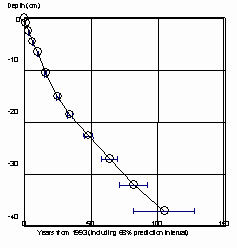Lead Isotope Dating
In conjunction with the Geosciences Advisory Unit at the National Oceanography Centre in Southampton we are able to offer this relatively new technique for precisely dating very recent sediments. This is particularly applicable in dating sediment accumulation rates for geohazard analysis in subsea engineering projects.
Application
Most suitable for dating very recent sediments suspected of being less than 100 years old.
Cost and turnaround time
Results are usually available within 2-3 weeks. Please contact us for more information.
Technical Information
|
Method Decay of uranium in the earth's crust releases the gas radon which produces 210Pb by decay in the atmosphere. The lead isotope enters the earth’s crust or the water through precipitation. In the water phase 210Pb is adsorbed to particulate matter and together they are deposited in the sediment. 210Pb decays with a half-life of about 22 years. The remaining amount of 210Pb at a certain depth will reveal the age of the given sediment layer within the last 75-100 years. The diagram below illustrates an age depth curve based on 210Pb analysis. |
|

